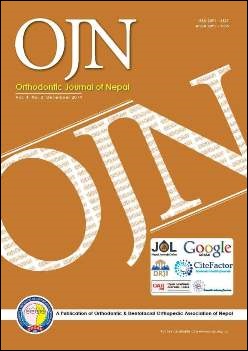The SAR Angle: A Contemorary Sagital Jaw Dysplasia Marker
DOI:
https://doi.org/10.3126/ojn.v4i2.13891Keywords:
anteriorposterior discrepancy, cephalometric diagnostic aid, sagittal discrepancyAbstract
Introduction: Cephalometric analysis forms the backbone of orthodontic diagnosis and treatment planning. However most of the angles used to assess antero-posterior jaw base discrepancy are based on landmarks that change with age, jaw rotation and orthodontic treatment. Walkers point is one landmark that has been suggested to be stable and easy to locate on radiograph.
Objective: To derive SAR angle based on Walkers point, points M and G to assess true sagittal discrepancy.
Materials & method: Sixty pretreatment lateral cephalograms of North Indian subjects were grouped in three classes of skeletal pattern based on fulfillment of any two of the three criteria: ANB angle, Witt’s appraisal and Beta angle. The mean and SD for the SAR angle in three groups were calculated. ANOVA one-way of variance and Newman-Keuls tests were done to compare the groups.
Result: The mean value for SAR angle of Class I skeletal pattern group was 55.98o (SD 2.24), whereas mean value for Class II and Class III skeletal groups were 50.18o and 63.65o with standard deviations 2.70 and 2.25 respectively. The receiver operating characteristic curves show that the cutoff point between Class I and Class II groups could be considered a SAR angle of approximately 53o, and the cutoff point between Class I and Class III groups could be considered a SAR angle of approximately 59o.
Conclusion: The SAR angle can be a reliable diagnostic aid to assess the sagittal jaw discrepancy more consistently.
Downloads
Downloads
Published
How to Cite
Issue
Section
License
Copyright © held by Orthodontic & Dentofacial Orthopedic Association of Nepal
- Copyright on any research article is transferred in full to the Orthodontic & Dentofacial Orthopedic Association of Nepal upon publication in the journal. The copyright transfer includes the right to reproduce and distribute the article in any form of reproduction (printing, electronic media or any other form).
- Articles in the Orthodontic Journal of Nepal are Open Access articles published under the Creative Commons CC BY License (https://creativecommons.org/licenses/by/4.0/)
- This license permits use, distribution and reproduction in any medium, provided the original work is properly cited.




